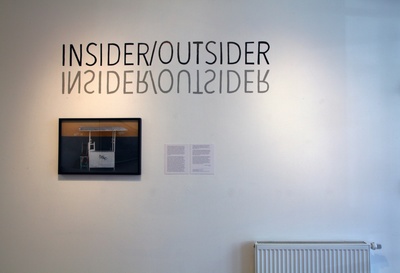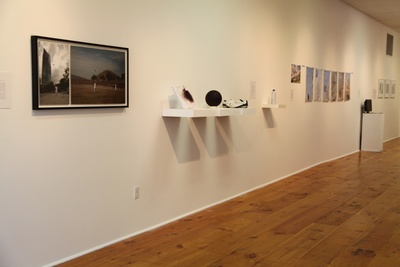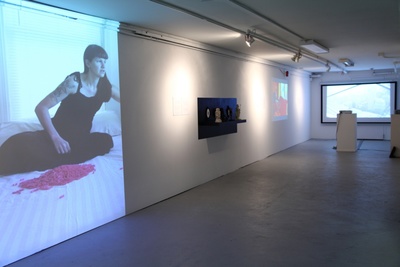Interview with Sandrine Schaefer
By Robert Moeller
Sandrine Schaefer is a Boston-based artist, educator, and independent curator. Her ephemeral artwork examines the shared experience of understanding the body in space, corporally and conceptually. Using a site-sensitive approach, she exercises durational endurance to explore the parameters of real time and investigate invisible space.
She is the recipient of several awards, grants, residencies, and exhibits internationally and is co-Founder of The Present Tense, an art initiative that produces and archives live art events, festivals, exhibitions and exchanges. We spoke recently.
RM: I was struck by how neatly you wove these disparate elements together for the show, Insider/Outsider that you recently curated at Lincoln Arts Project. The work sometimes was just traces of things, fragments. How did the internal organization initially cohere?
SS: My concept for Insider/Outsider was to feature live-art pieces that were originally created in non-art contexts. I invited four artists to participate and then did an international open call for submissions to see what kind of work would surface. My initial vision was to include five-six artists. I was so inspired by the submissions I received through the open call that I expanded the exhibition to include a dozen artists. Dispersing my concept through different art communities and seeing what came back to me allowed the initial concept for the exhibition to develop in ways I couldn’t anticipate. For example, I received work that negotiated private and intimate spaces in ways I didn’t expect (Jodie Goodnaugh’s 36,835, Chun Hua Dong’s The Husbands and I, and Joshua Schwebel’s Prelude). This was really exciting.
I wanted Insider/Outsider to represent a spectrum of how artists are thinking about the concept of place and how it informs their practices. Once I compiled all of the physical evidence from this work, I organized it visually. For example, I placed the relics from Vela Phelan’s A God’s Shadow between video projections. In this piece, Phelan cast the shadows of statues of various gods and goddesses throughout Boston.
Before people encountered Phelan’s piece, they would often walk in front of the projection of Jodie Goodnough’s video, casting their own shadows on the wall. This was an intentional choice to weave these pieces together.
Some of the work tackled darker issues (Joshua Schwebel’s Prelude, Joanne Rice’s The Human Cost of War, Milan Kohout’s Three video pieces, and Lezli Rubin-Kunda’s City-Shelter. I decided to adjust the exhibition so that the objects, photos and videos were emotionally balanced. The pieces that were dealing with war and violence were placed next to pieces that took on a playful approach (Meredith and Anna’s Red Carpet, Jeffrey Byrd’s Public Art and Sylvia Schwenk’s Along White Lines). I acknowledged that Insider/Outsider might be challenging for some people.
I wanted to organize the exhibition so that the audience would stick with the show…experience it in its entirety.
RM: There is a forensic quality to what you are doing, a gathering of evidence, as you say. Is there ever a danger of missing something? Or is the incompleteness part of it?
SS: This kind of experiential art (live art, action art, performance art, etc.) only exists in the moment that it is being made. It is impossible to document the totality of these pieces. There is a tremendous amount of information that gets lost. Part of my interest in Insider/Outsider was to see how other artists document their work…what information do they share, how much is “enough”?
I have been organizing and producing live art events, festivals, and exchanges through my live art initiative, The Present Tense, since 2005. In 2009, The Present Tense launched a web-based archive. Since then, I have been immersed in this complex relationship between live art and its documentation. I have learned that each piece requires something different and that there is no standard. My intention with Insider/Outsider and with The Present Tense Archive is to further develop a vocabulary to talk about this kind of work and to inspire people to go out and experience it live.
RM: Of the parts lost, does that information have an inherent weight? Is the supposition that a thing might have happened a certain way become a powerful force? Even in hindsight?
SS: The missing parts make the experience of viewing this work participatory. It demands that the audience engage in the act of imagining how the pieces actually unfolded. I think this is an extremely powerful part of the exhibition. Many of the people who witnessed Insider/Outsider asked a lot of questions.
People wanted to know if Jodie Goodnough’s pills were real and what they smelled like in that quantity. People wanted to know if Catherine Chun Hua Dong felt safe and if she had sexual relations with all the people she “married” in her piece, The Husbands and I. Someone asked me what happened if Milan Kohout had to go to the bathroom while he was locked in a cage in his piece (appropriately titled) Cage. These are all visceral responses to the work. What this tells me is that the missing parts allowed the audience to empathize with these artists. They could identify with the work on a basic human level.
RM: I’m curious, is it the curator’s role to fill in the blank spaces, to be on hand as a sort of interpreter of the work? Is there a danger of a line being crossed where there is too much hand holding or coddling of the audience?
SS: There needs to be a balance. The goal is for the audience to find an authentic entry point into the work, without much suggestion, but there is also a responsibility to represent the work in a way that is sensitive to the context and time in which it is being shown. Insider/Outsider was the first exhibition at LAP that focused on performative time-based art practices. This is why I chose to include so much writing in the exhibition. Without enough information, it could be easy to dismiss the work.
RM: Nicely put. But I imagine that it is a trickier proposition in practice. Would that entry point into the work be different for different people? Is that editing down of the information dangerous? I mean marking the jumping-off point for a viewer.
SS: We are talking about a common conundrum…the complex relationship between live art and its documentation. It is both tricky and dangerous because the “art” is the creative process rather than a product of a creative process. How can you authentically represent something that only exists in the moment that it was made? If you try to represent a live art piece through an object, doesn’t that go against the intention behind the original piece? Ultimately, I would rather tackle these questions to inspire dialogue and in the instance of Insider/Outsider, share work that may never get seen otherwise because of the work’s original context.
From a curatorial standpoint, it is also tricky because the artists have made decisions about what information to share. By choosing to show this kind of work, I am agreeing to show what documents exist and offering my reading of that work. Much of the information that I am going off of is dictated by the artist, unless it was a piece that I witnessed live. Insider/Outsider was a collaboration between the artists and me. On top of this, different viewers will have different entry points into each piece of work. Being aware of this, I tried to remain as neutral as possible in how I wrote about each piece.
RM: Tightrope walking between the artist and the audience, or perhaps, from the artist toward the audience can be a fraught process. What general guidelines do you use to avoid misunderstandings?
SS: This is where curating from an artist’s perspective is helpful. I approach each piece that I show with the same intention that I would bring to showing my own work. Misunderstandings are inevitable. Not every piece will resonate with every viewer. I think most artists accept this and recognize the learning that can come from misunderstandings—the opportunity to get closer to understanding your ideal context, strategies for how to represent your vision, how you want to operate professionally, etc.
Before going into any curatorial project, I share my intentions with the artists I wish to show. If the artists know that I have a connection to their work and that my intention is coming from an authentic desire to share it because it moved me, it establishes me as an advocate for their work. This makes any misunderstandings that might come up easier to deal with.
It is important to note that Insider/Outsider was unique in that it was the first exhibition I’ve curated that consisted of documentation only. I primarily curate live art events where the participating artists are present and create pieces specifically for the event/festival/happening. I enjoy working in this way, directly with artists to realize their work. I approached Insider/Outsider similarly.
One of the most exciting things about curating and showing work in a live event is getting to connect with the other participating artists and experience their work. This wasn’t possible for many of the artists who were part of Insider/Outsider, so I self-published an exhibition catalogue and sent PDF copies to all the artists. Obviously, a catalog isn’t the same as the experience of walking through an exhibition, but it creates an opportunity for the artists to get a sense of what that experience was like.
Robert Moeller is a painter and writer and the website coordinator of artnewengland online.



